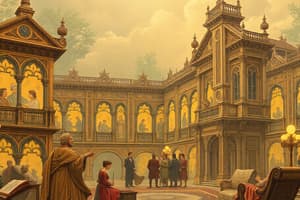Podcast
Questions and Answers
What concept primarily guided Renaissance philosophy?
What concept primarily guided Renaissance philosophy?
- Monasticism
- Humanism (correct)
- Religious devotion
- Feudalism
Which family is most notably associated with the patronage of arts during the Renaissance in Florence?
Which family is most notably associated with the patronage of arts during the Renaissance in Florence?
- Papal
- Medici (correct)
- Sforza
- Borgia
Which work is attributed to Leonardo da Vinci?
Which work is attributed to Leonardo da Vinci?
- Utopia
- Mona Lisa (correct)
- The Prince
- Decameron
Who is regarded as the 'Father of Renaissance'?
Who is regarded as the 'Father of Renaissance'?
What is a central theme of Thomas More's 'Utopia'?
What is a central theme of Thomas More's 'Utopia'?
Which artist is famous for the statue of David?
Which artist is famous for the statue of David?
Who wrote 'Praise of Folly'?
Who wrote 'Praise of Folly'?
Which of the following is a characteristic of the Renaissance period?
Which of the following is a characteristic of the Renaissance period?
Flashcards
Renaissance
Renaissance
A period of creativity and renewed interest in Roman and Greek cultures.
Humanism
Humanism
A philosophy that emphasizes individual values, skills, and potential.
Francesco Petrarch
Francesco Petrarch
Considered the 'Father of the Renaissance' in literature.
Niccolò Machiavelli
Niccolò Machiavelli
Signup and view all the flashcards
Michelangelo Buonarroti
Michelangelo Buonarroti
Signup and view all the flashcards
Leonardo da Vinci
Leonardo da Vinci
Signup and view all the flashcards
Filippo Brunelleschi
Filippo Brunelleschi
Signup and view all the flashcards
Utopia
Utopia
Signup and view all the flashcards
Study Notes
Renaissance Overview
- The Renaissance was a period of creativity and revived interest in Roman and Greek cultures.
- "Renaissance" (French), "Renasci" (Latin) meaning "rebirth" originated in Florence, Italy.
- This period was characterized by a focus on individuals, their skills, interests, dignity, and ability to progress (Humanism).
Influential Factors in Italy
- Influential merchants, especially the Medici family, supported artistic endeavors.
- Greek and Roman traditions served as sources of inspiration.
Important Literary Figures
- Francesco Petrarch: Considered the "Father of the Renaissance."
- Giovanni Boccaccio: Author of the Decameron, a collection of stories, set during the Black Death.
- Niccolò Machiavelli: The father of Modern Political Theory, author of "The Prince."
- Geoffrey Chaucer: Known as the father of English essays and author of the Canterbury Tales.
- Thomas More: Author of "Utopia," a work that describes an ideal society.
- William Shakespeare: Well-known English author, noted for plays like Macbeth, Hamlet, and Romeo and Juliet.
- Desiderius Erasmus: Author of "Praise of Folly."
- Miguel de Cervantes: Author of "Don Quixote."
Key Aspects of Renaissance Arts
- Filippo Brunelleschi: Designed the dome of the Florence cathedral of Sta. Maria del Fiore (1420).
- Michelangelo Buonarroti: Created the Sistine Chapel, David, and The Pieta.
- Leonardo da Vinci: Famous for Mona Lisa and the Last Supper.
- Raphael Santi: Known for paintings like Madonna and School of Athens.
- Sandro Botticelli: His notable works include The Birth of Venus and Primavera.
- Donatello: Made bronze statues, including a renowned David.
Spread of Renaissance
- Renaissance masterpieces sparked interest among scholars.
- Increased trade spread Renaissance ideas throughout Europe.
- Wealthy nobles supported Renaissance artists with patronage.
- Johannes Gutenberg's printing press played a vital role in disseminating information and ideas.
Studying That Suits You
Use AI to generate personalized quizzes and flashcards to suit your learning preferences.




